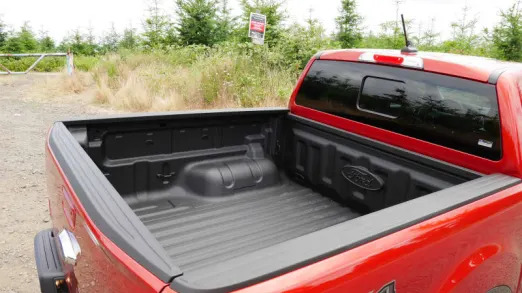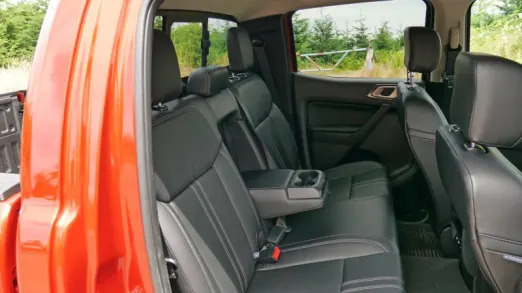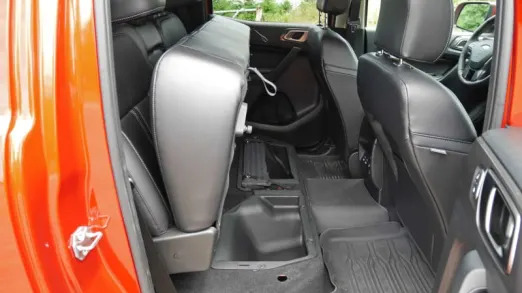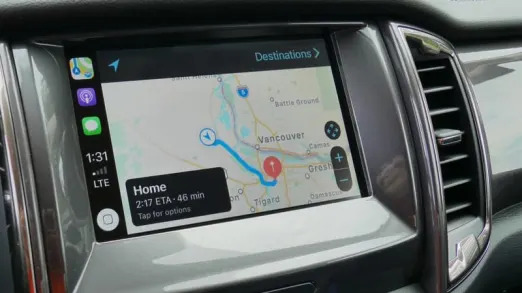-
TrimLariat 4x4 SuperCrew
-
Engine2.3L Turbo I-4
-
Power270 HP / 310 LB-FT
-
Transmission10-Speed Auto
-
Drivetrain4x4
-
Curb Weight4,441 LBS
-
Seating2+3
-
MPG22 MPG Comb.
-
Base Price$39,580
-
As Tested Price$45,355
We've already written quite a lot about the 2019 Ford Ranger, including going so far as to name it the winner of our four-truck comparison test. That Ranger was a mid-grade XLT truck, which seems likely to be the volume-selling choice. The Ranger you see here is a Lariat loaded with every bell and whistle for a grand total of $45,355, which is within spitting distance of an F-150 SuperCrew Lariat's base price of $45,655. Now, the Ranger has more equipment and four-wheel-drive at that price point, but you're also getting far less truck.
Perhaps that won't matter for some, because in certain environments, the Ranger just makes more sense. Driving it around Portland, Ore., for a week was exponentially more pleasant than driving an F-150. It's easier to park and to maneuver on tight streets. Passing cyclists doesn’t instill a fear that you’re going to smack them in the noggin with a tow mirror. Driving the Ranger is just less stressful.
Away from the city, its handling is also pleasantly responsive and the ride is excellent, even if the solid rear axle and leaf springs still cause some jittery motions over high-frequency bumps. It may not be the highway cruiser an F-150 is, but it's also acceptably livable out on the open road with comfy seats and ample sound deadening. One must also praise the smooth and responsive four-cylinder turbo engine, which feels like a sophisticated powerplant in a segment where that's not expected. I didn't notice the low-speed hesitation from the 10-speed automatic as the boys in Michigan did, but they also tested it far more extensively.


Someone leaning towards a Ranger in lieu of an F-150 must recognize that they don’t need the all-out capability of a fullsize truck. Fair enough, but in terms of utility, the Ranger could be better when compared to those in its own segment. Yes, it has the most voluminous 5-foot bed, but the SuperCrew is also only available with a 5-foot bed. The Toyota Tacoma (6 feet) and Chevy Colorado (6.2) offer long-bed options with their crew cabs. I could casually chuck my bicycle into the bed of either of those and close the tailgate. Not so much in the Ranger.
Then there's the Ranger SuperCrew's back seat. Its bottom flips up and its back flips down, but it's not 60/40-split as the Tacoma and Colorado's are. As such, we had to put my mother-in-law's suitcase on the seat next to her, rather than on the folded seatback, as you can in the Tacoma, or on the flat floor as in the F-150 and other full-size trucks (the Ranger's floor has a questionably useful quasi-bin area under the seat). This reduces the Ranger's functionality as a daily driver, which is a shame, because it otherwise can excel at it.


As for how the Lariat compares to the XLT we previously tested, it comes standard with 18-inch wheels (versus 17's), LED headlights, fancier exterior trim, leather upholstery, and proximity entry and push-button start (with controls on each door). Our test truck also included the 501A package, which includes automatic wipers, a 10-speaker B&O sound system and a well-executed adaptive cruise control system.
Now, since the Ranger Lariat includes the Sync3 infotainment system, it's impossible to talk about the truck’s overall livability without pointing out some of that system’s flaws. Although this version supposedly comes with integrated navigation, it infuriatingly gets blacked out when you plug in your phone to Apple CarPlay or Android Auto. This is a problem on multiple levels. First, the on-screen button for Ford navigation is replaced by one that says "Maps," which in the case of CarPlay, takes you to Apple Maps. No thank you. You can still access the Google Maps app through CarPlay, but even that's imperfect. Though it's the superior smartphone navigation tool, internet service isn't available everywhere and you need it to enter a new destination with Google Maps. Integrated navigation works everywhere, but if you want to use it in a Ford, you can't use the entertainment elements of Apple CarPlay and Android Auto at the same time. Ford is the only company I know to do this (including Lincoln) and is certainly aware of the problem – the USB ports on the 2020 Explorer during its first drive event were taped off to prevent people from overriding the navigation system's pre-programmed drive route.
It is also irritating to go between Apple CarPlay and the car's native infotainment controls, such as those for the radio. I had to press or swipe the screen four times just to go between Google Maps and satellite radio presets. Other vehicles offer a physical Home button, or better still, dedicated physical buttons for things like the radio. Admittedly, however, I could've written the exact same thing about the $73,680 F-150 Platinum.


Unlike in that range-topping F-150, however, Ford doesn't quite go to the same efforts to spruce up the top-of-the-line Ranger's cabin. Oh, it has leather and some stitching on the dash, but the hard plastic door sills could use some padding given that they're perfectly sized and placed to rest your arm. The heated front seats also offer six-way power adjustment, but the back rest is manually operated.
That said, the Ranger cabin is still a far more pleasant place than the Colorado's, which looks and feels cheap even at this elevated price point. The Ford also has a more natural driving position than the Tacoma, and is generally more livable with a considerably more comfortable back seat. My mother-in-law's luggage may have had to ride on the seat with her, but she also reported having more than enough room and was plenty comfortable, apart from the lack of rear air vents. She wasn't assuaged when I said no truck in the segment has those apart from the Honda Ridgeline, and that it was pretty cool the Ranger at least has two USB ports for rear passengers.
In general, a price tag of more than $45,000 may seem steep for a midsize truck, but know that the Ranger isn't atypical for the segment. If anything, its comfort, interior ambiance and driving experience help it provide stronger value. Now, some might say that it doesn't make sense to buy a Ranger Lariat for the same price as a F-150 Lariat, even if there's an equipment disparity. However, bigger isn't always better for everyone. The choice depends on how much truck you really need and how big of a pain in the ass it is to drive where you live. If anything, that the Ranger exists at all for such a debate to occur should be applauded. More choice is rarely a bad a thing, and in the case of truck shoppers at the local Ford store, the available choices are pretty good ones.











Sign in to post
Please sign in to leave a comment.
Continue